This publication provides an overview of the growth of high tunnel production and the organic produce sector. It introduces high tunnel structures and environmental modifications and outlines the major advantages of using high tunnels to enhance organic vegetable production. Major challenges of high tunnel management for organic vegetable production in Florida are also discussed. The publication provides general guidance and information for high tunnel growers, organic vegetable producers, and anyone interested in growing organic crops under protected culture.
What Is a High Tunnel?
High tunnels (also called hoop houses) are passively heated and cooled structures that are typically plastic-covered and often used to extend the growing season. They have also been shown to improve the marketable yield and quality of high-value fresh-market horticultural crops such as vegetables, fruit, and flowers (Carey et al. 2009; Frey et al. 2020a). Unlike regular greenhouses, high tunnel structures provide less environmental control and may not have electrical service, automated ventilation, or permanent heating systems (Lamont 2009).
Different Types of High Tunnels
Both single- and multi-bay high tunnel structures are used by growers. Single-bay high tunnels are freestanding, low-footprint structures typically ranging from 14 ft. to 40 ft. in width, 9 ft. to 15 ft. in height, and 36 ft. to 200 ft. in length (Figure 1). Caterpillar high tunnels can be a lower-cost option with a narrow single-bay structure (Figure 2). They are intended as temporary structures which may not withstand significant wind or snow unless reinforced with extra support (Cornell University 2022). The width of a caterpillar high tunnel varies between 6 ft. to 20 ft., with a typical height of 6 ft. to 9 ft.
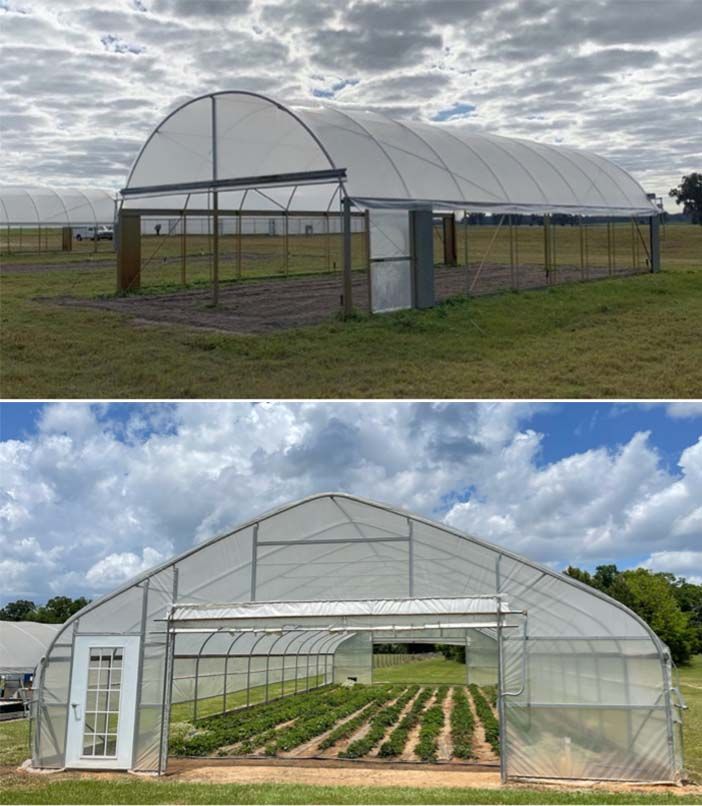
Credit: Isaac Vincent and Shufang Tian, UF/IFAS

Credit: Tian Gong and Isaac R. Vincent, UF/IFAS
Single-bay high tunnels, including caterpillar tunnels, come in one of two roof shapes: Gothic (peaked) and Quonset (hooped) (Figure 1). Single-bay high tunnels with a Gothic arched roof can shed snow better than those with a Quonset roof. Thus, Gothic roofs are more commonly used in temperate regions. Single-bay tunnels with a hooped roof and rounded or straight sidewalls are popular in tropical climates. Multi-bay high tunnels consist of individual bays that are joined at the sides to provide structural stability and, in some cases, more protection from cold temperatures (Figure 3). These bays typically have rounded roofs and may have a gutter between them to channel rainwater, although they cannot hold heavy snow loads. Multi-bay tunnels are more susceptible to wind damage than single-bay tunnels (Heidenreich et al. 2012). The width of a single bay is typically between 18 ft. to 30 ft.; but the size and number of a multi-bay high tunnel system can vary widely depending on the manufacturer and the farming operation.
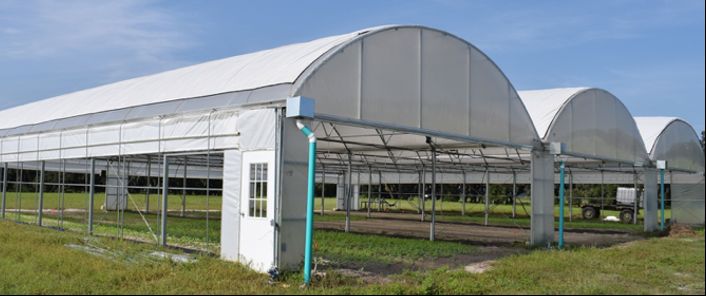
Credit: Shufang Tian, UF/IFAS
Ventilation and Microclimate Management
Many factors should be considered before purchasing and installing a high tunnel, including geographic location, growing needs, and budget. Since high tunnels rely primarily on passive ventilation, approaches to managing the microclimate inside the high tunnels are limited. Sidewalls and end walls can be rolled up manually or operated with automatic systems to aid ventilation (Figure 4). Exhaust fans and circulating fans may be installed to improve ventilation and temperature control. Some high tunnels may even have ridge vents that open in the roof of the structure, allowing warm air to escape. Though vents are effective, they may be cost-prohibitive for some growers.
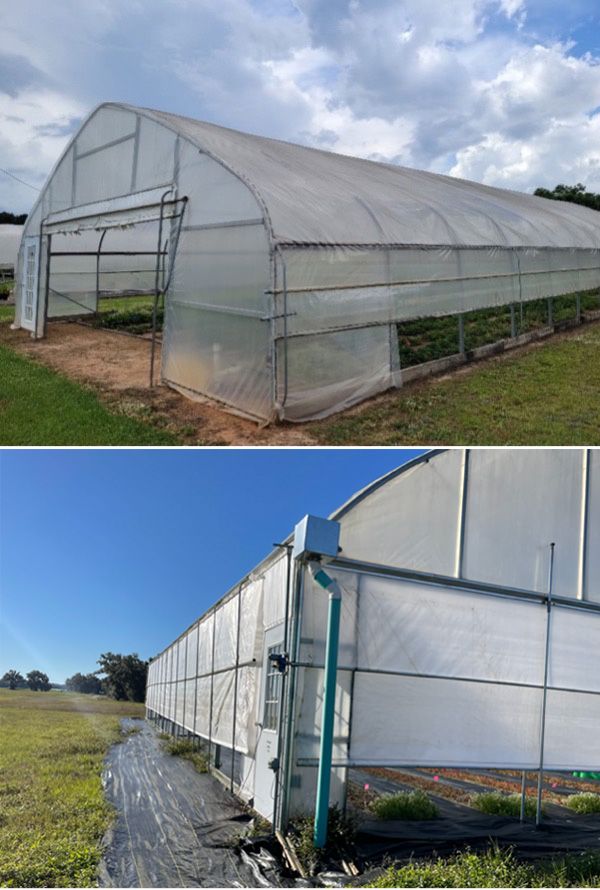
Credit: Xin Zhao and Shufang Tian, UF/IFAS
High tunnel frames are usually covered with one or two layers of polyethylene film (Kaiser and Ernst 2012); in the latter case, an inflated air layer exists in between the two layers (Figure 5). The double-layer roof provides better insulation and cold protection when installed with an inflation fan; but the two layers may reduce light penetration by about 3%–15% more than would a single layer of plastic (Maynard and O’Donnell 2018). In subtropical and tropical areas, growers may use an economical high tunnel-like screen house with a top-vented and poly-covered roof (Figure 6), in lieu of a regular high tunnel, to protect crops from the rain, if that is the main purpose of protected culture. Using screen side- and end-walls, this type of structure also helps prevent excessive light penetration and exclude certain pests.
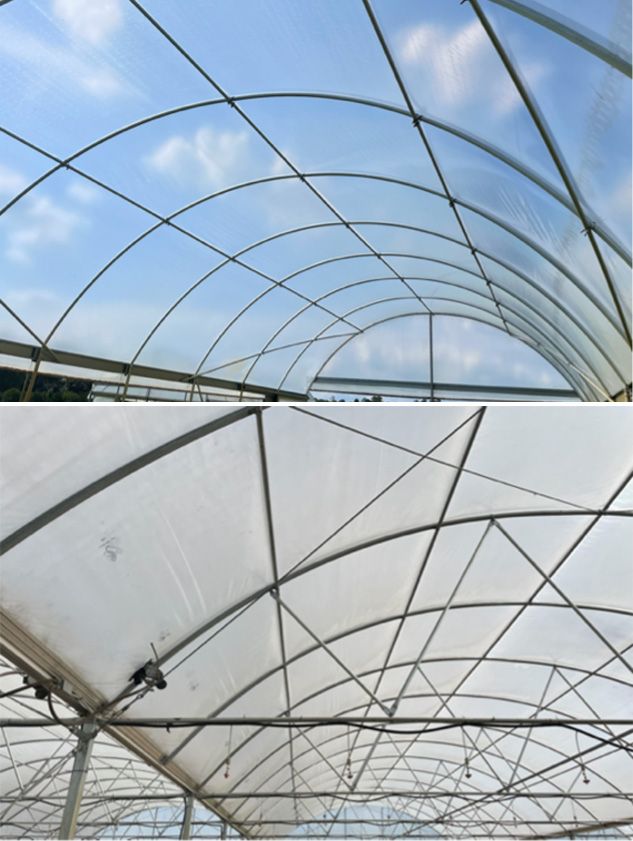
Credit: Shufang Tian, UF/IFAS
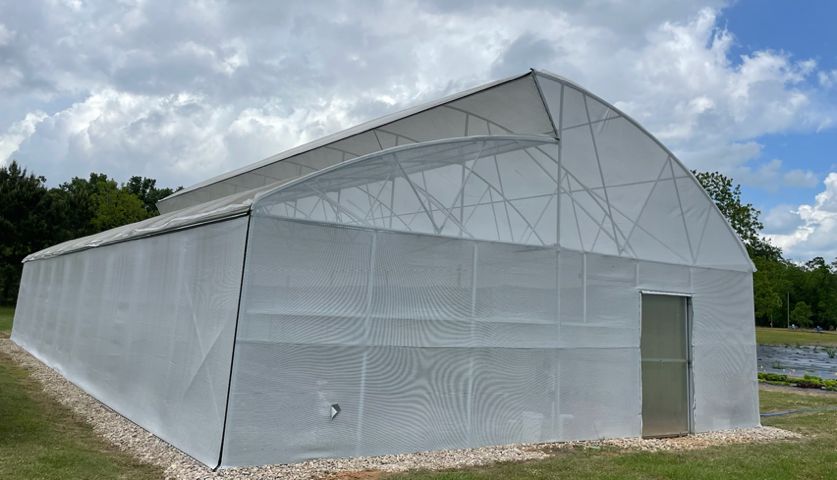
Credit: Shufang Tian, UF/IFAS
High Tunnels as a Production Tool and a Conservation Practice
Compared to many other countries, the United States has lagged in adopting high tunnel production systems. Accompanying high tunnel research and Extension efforts were not carried out before the early 1990s, when the potential of using high tunnels for growing vegetables in the northeastern US began to be more widely recognized (Carey et al. 2009; Lamont 2009; Wells 1996). Some of the main high-value crops for high tunnel systems include tomato (Solanum lycopersicum), pepper (Capsicum annuum), eggplant (Solanum melongena), cucumber (Cucumis sativus), and melon (Cucumis melo). Oriental and leafy green vegetables and berry crops—such as strawberry (Fragaria ×ananassa), raspberry (Rubus idaeus), blueberry (Vaccinium corymbosum), and blackberry (Rubus armeniacus)—also grow well in high tunnel systems (Carey et al. 2009; Lamont 2009). The most popular vegetables grown under protected structures in Florida include tomato, pepper, lettuce (Lactuca sativa), and cucumber (Hochmuth and Toro 2014) (Figure 7); inside high tunnels, these are often planted in the ground on flat or raised beds (Figure 8). For high tunnel production, a grower should consider their crops, production systems, and budget to decide whether to hand water or use overhead or drip irrigation (Simonne et al. 2008).
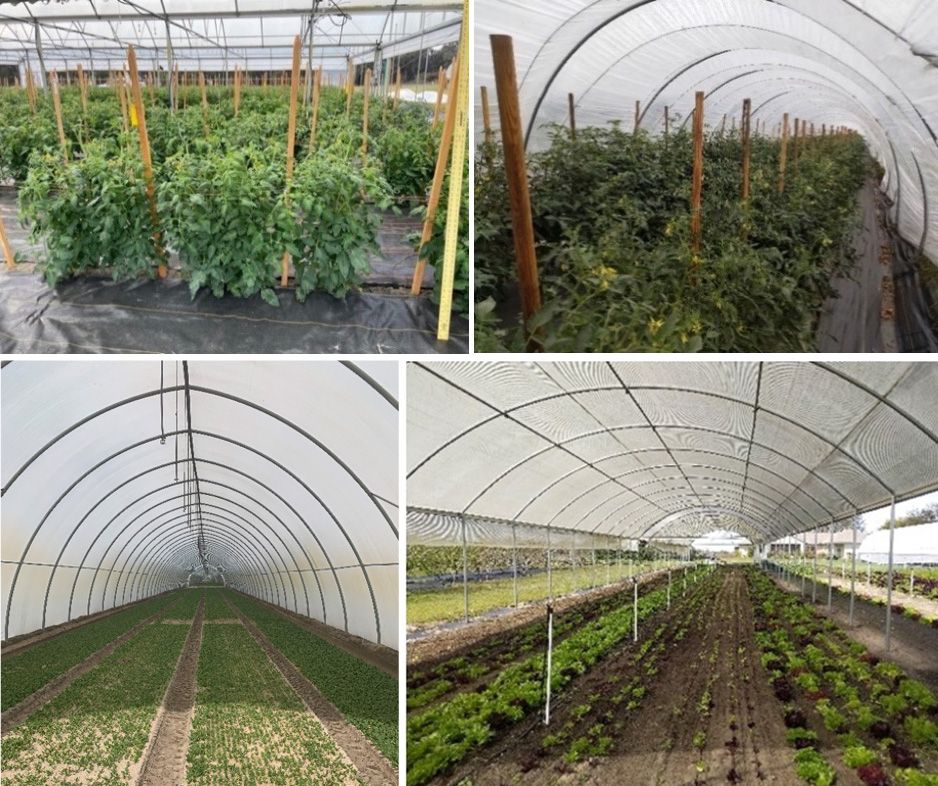
Credit: Shufang Tian, Isaac R. Vincent, and Xin Zhao, UF/IFAS

Credit: Shufang Tian and Zachary E. Black, UF/IFAS
Increasing Adoption of High Tunnel Systems
Since 2010, the Environmental Quality Incentives Program (EQIP) from the Natural Resources Conservation Service (NRCS) has implemented the High Tunnel System Initiative to offer technical and financial assistance to promote the adoption of high tunnels in all states (USDA-NRCS 2022). The NRCS-EQIP high tunnel initiative promotes soil-based high tunnel systems by emphasizing high tunnel benefits for conservation, soil and plant quality improvement, and input resource use efficiency enhancement. According to Hochmuth and Toro (2014), the use of high tunnels in Florida grew from nearly 0 acres in 2001 to 186.4 acres in 2013. The rate of adoption of the system by small and large operations in Florida has continued to rise since the survey was conducted, driving the need for further research and Extension efforts.
High Tunnels for Organic Vegetable Production
Organic production within high tunnels can add value to vegetable crops and help increase the economic return on investment. According to the USDA National Organic Program, organic production is a holistic production system that integrates “cultural, biological and mechanical practices that foster cycling of resources, promote ecological balance and conserve biodiversity” (USDA 2022). Most synthetic, chemical fertilizers and pesticides are prohibited in certified organic production. A systems approach and integrated practices are at the core of soil and plant health management for growing organic crops. Organic farmers identified major challenges to production including managing soil fertility and crop nutrition; controlling weeds, pests, and diseases; and maintaining adequate yields (Snyder, Schonbeck, and Vélez 2022).
In Florida, organic farmers may face greater obstacles associated with warm and humid tropical and subtropical environments as well as sandy soil conditions characterized by low intrinsic levels of organic matter. These conditions make it difficult to manage soil, pests, disease, and weeds. According to the 2021 Organic Survey, sales of organic fruits (including berries) and vegetables in the US surpassed $4.1 billion (USDA-NASS 2022). The numbers of large and small organic operations in Florida have increased since 2002, with over 110 organic fruit and vegetable farms operating in Florida as of 2021, generating sales of more than $72 million. However, total operations and sales of organic crop commodities in Florida remain relatively small compared with states like California, whose sales of more than $3.6 billion were generated from over 3,000 operations in 2021 (USDA-NASS 2022).
It is noteworthy that from 2016 to 2019, the US sales of organic vegetables in protected agriculture systems increased by 49%, reaching a total of $133 million (USDA-NASS 2020). High tunnels are becoming increasingly popular due to the growing demand for locally grown organic vegetables in the United States (O’Connell and Tate 2017). There is also a rising trend of high tunnel vegetable production in Florida. In 2016, 800 high tunnels were built on 150 acres in Jennings, FL. To meet the rapidly growing consumer demand for baby leafy greens along the eastern US coastal market, an additional 70 tunnels were explicitly used for organic production in 2018 (Giles 2019). It is expected that—as new research demonstrates the integrated use and benefits of organically managed high tunnel systems—more organic growers will consider high tunnels to help enhance organic vegetable production in Florida (Frey et al. 2020a, 2020b).
Advantages of Using High Tunnels to Benefit Organic Production in Florida
There are many advantages to using high tunnel systems for organic production; the most important and widely recognized benefits include season extension, increased crop yield, and the enhancement of produce quality (Frey et al. 2020a; Lamont 2009; Lei and McDonald 2019). Earliness and season extension achieved by cost-effective high tunnel systems may help organic growers secure premium prices in novel markets, thus helping justify the cost of organic operations. In addition, high tunnels have been shown to reduce fruit cracking and decay in tomato production (Frey et al. 2020a). High tunnels using shade cloths have been demonstrated to reduce the severity of bolting for leafy greens (Zhao and Carey 2009).
Microclimate Management for Improving Crop Yield and Quality
Microclimate conditions have been shown to directly impact crop yield and quality. Temperature, humidity, and rainfall may fluctuate drastically on a daily basis in tropical and subtropical environments, making microclimate management in high tunnels of particular importance. Active microclimate management can be conducted in high tunnel systems; and high tunnels can be used to achieve earliness or extend the production window by minimizing crop losses in the late fall, winter, and early spring months, when cold and frost damages pose a potential risk. Shade cloth can be used over the high tunnel during the hot summer period for tomato production. Shade cloth can also help lower the temperature within the high tunnel in late spring or early fall for leafy green production (Figure 9). While elevated fogging systems are widely and successfully used to cool air temperatures in commercial greenhouse structures (Figure 9), research conducted in Georgia showed that they were only marginally effective in high tunnels. The lower rate of air movement in the passively ventilated structure hindered elevated fogging systems (Laur et al. 2021a). If growers wish to use a fogging system, they should consider adding horizontal airflow fans to their structure, which help improve air movement and evaporation.
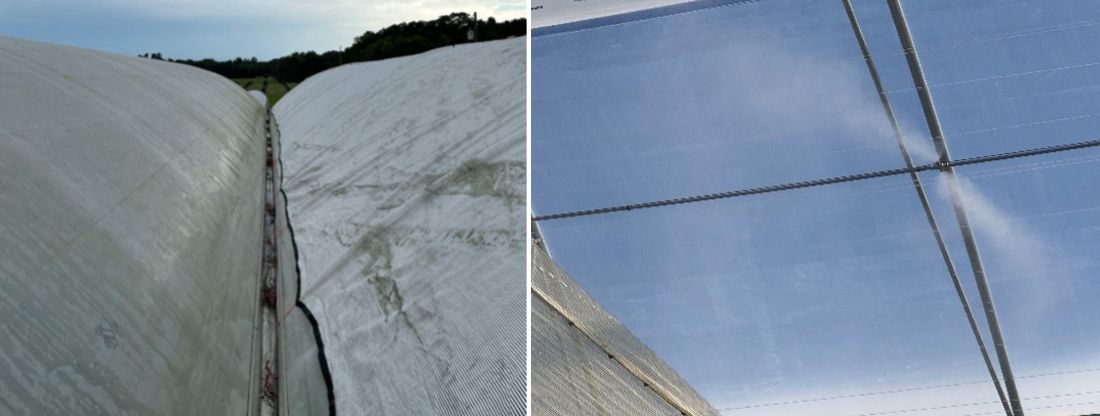
Credit: Shufang Tian, UF/IFAS, and Timothy W. Coolong, UGA
Excessive shading should also be avoided to prevent adverse impacts on plant growth and development. Research in Georgia has shown that although temperatures remain high, light levels rapidly decrease in October, resulting in reduced growth when shade cloth is used. Freeze protection may also be needed for growing warm season crops during the winter months in Florida. According to the USDA Plant Hardiness Zone Map (https://planthardiness.ars.usda.gov/) based on the average annual minimum winter temperature during 1976–2005, Florida encompasses several hardiness zones ranging in minimum temperatures from 40°F–45°F (hardiness zone 11a) to 10°F–15°F (hardiness zone 8a). Upon evaluating chilling or freeze injury risks and crop needs, growers may consider using high tunnels when they seek cost-effective tools for crop protection. Depending on the frost level and duration, portable heaters and row covers (over or inside the tunnel) can be employed to protect plants (Figure 10). Growers may also place barrels or buckets filled with hot water inside the high tunnel to help keep the space warm at night.

Credit: Shufang Tian, Tian Gong, and Xin Zhao, UF/IFAS
Exclusion of Rainfall and Protection from Weeds, Diseases, and Pests
High tunnels support year-round production by protecting crops against rainfall, the wind, and drastic temperature fluctuations. Weeds are a significant concern in organic production, and weed management can be laborious in Florida’s warm and humid climate. High temperatures and frequent rainfall contribute to the rapid growth of weeds in the field. High tunnel structures can thus help control weeds by limiting wind and rain (Figure 11). The extensive adoption of drip irrigation in high tunnels may also help reduce weed pressure (Sánchez, Lamont, and Orzolek 2008).
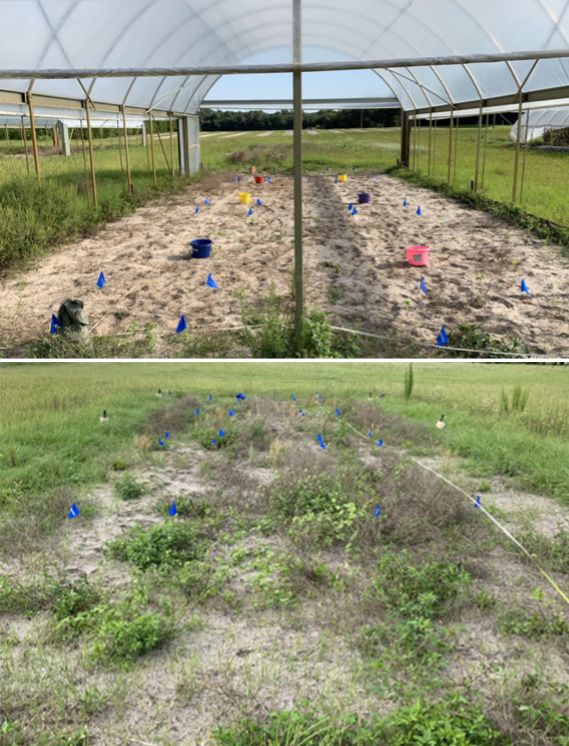
Credit: Isaac R. Vincent, UF/IFAS
Rainfall protection by high tunnels also helps reduce the incidence and severity of some foliar diseases by limiting leaf wetness duration and spore dispersal. Studies have indicated lower severity of bacterial speck (Pseudomonas syringae pv. tomato) and early blight (Alternaria solani) in tomatoes under high tunnel production than those in an open field (Frey et al. 2020; O’Connell et al. 2012). In addition, if microclimate manipulation and biological control is effectively implemented, high tunnel structures can significantly limit the population of some major arthropod pests including whiteflies (Bemisia tabaci), thrips (Frankliniella spp.), and aphids (Aphis gossypii) (Frey et al. 2020b; Healy, Emerson, and Dawson. 2017; O’Connell et al. 2012).
Natural pest control strategies, such as conservation biological control and companion planting, can be employed to manage pests in high tunnel organic vegetable production systems. Research in north Florida indicated that repellent plants—i.e., mustard (Brassica juncea)—may be interplanted with leafy greens to repel (or “push” away) the pests. Trap crops may also be deployed to attract (or “pull”) the pests into non-cash trap crops where they may be controlled, preferably using biological methods. Used in conjunction, the synergistic strategies are referred to as “push-pull” technology (Pyke et al. 1987). Furthermore, beneficial predatory insects are attracted and sustained by using flowering plants—such as marigold (Tagetes erecta) and sweet alyssum (Lobularia maritima)—as companion crops. Push-pull technology may be complemented by companion planting of flowering plants to enhance the effectiveness of biological control agents.
By excluding rainfall, the high tunnel environment may also help improve the efficacy of organic insecticides and fungicides. Moreover, insect nettings on the sidewalls of high tunnels could add another physical barrier to facilitate pest exclusion, provided that environmental conditions inside the high tunnel remain favorable for the crop (Pottorff and Panter 2009). Given the sandy soil texture at many vegetable farms in Florida, a high tunnel-protected culture may also offer unique benefits in reducing nitrate leaching through the exclusion of rainfall and enhancing nutrient availability and use efficiency. By helping manage diseases, pests, soil, and nutrients, high tunnel systems can improve the overall quality and productivity of many vegetable crops (Frey et al. 2020b).
Challenges of Using High Tunnels in Florida
While high tunnel systems can offer multifaceted benefits for improving organic vegetable crop production, management challenges still need to be recognized and overcome to prevent crop losses and maximize return on investment.
Pest and Disease Management
High humidity inside high tunnels without proper ventilation management may encourage the proliferation of diseases such as powdery mildew (Oidium neolycopersici) and leaf mold (Fulvia fulva) in tomato production (Frey et al. 2020b; Warren, Sideman, and Smith 2015). In addition, pests such as two-spotted spider mites, russet mites, stinkbugs, and certain types of caterpillars can quickly multiply in high tunnels, and populations of soilborne pathogens or parasitic nematodes may increase over time due to warmer soil conditions and long crop cycles within the protected structure. Moreover, if some airborne pathogens and pests survive inside high tunnels over the winter, there can be an early outbreak of diseases or pests in the subsequent spring season. Integrated use of cultural, physical, and biological practices is recommended for pest and disease management in high tunnel organic vegetable production systems. These systems may include cover cropping, crop rotation, biodiversity enhancement, mulching, compost application, grafting, resistant cultivars, and soil solarization (Frey et al. 2020b; Hanson, Mahato, and Schuch 2014; Millner et al. 2009; O’Connell et al. 2012; Rudisill et al. 2015; Zambon et al. 2013).
Heat Management
Excess heat management can be challenging for high tunnel growers in warm climates. The authors of this publication have observed that high tunnel temperatures can exceed 120°F even during winter months on clear, sunny days. In these cases, the tunnels were not adequately vented. Growers often encounter issues with starting cool-season crops in the late summer and fall in tunnels. Research in Georgia and Kansas has shown the effectiveness of using shade cloth to grow cool season crops out of season (Laur et al. 2021b; Zhao and Carey 2009) (Figure 12). Late summer in South Georgia, shade nets that covered the high tunnel improved tomato plant growth (Bag et al. 2021). Some growers have experimented with movable high tunnels, starting crops in the field in the fall and moving the high tunnel over the crop once ambient temperatures decrease enough to limit growth.

Credit: Timothy W. Coolong and Savanah Laur, UGA
Nutrient Management
Nutrient management is another major challenge for organic growers, and the intensive cropping nature of high tunnel production requires more attention to nutrient management than open fields do, which may translate into higher labor and other variable costs (Bruce, Maynard, and Farmer 2019). As the relatively warm conditions inside high tunnels help promote soil organic matter decomposition and organic nutrient mineralization, short-term and long-term management plans need to be developed to maintain and improve soil fertility and health for Florida sandy soils in high tunnel systems. For organic crop production, matching available nitrogen with crop demand remains challenging (Bi et al. 2021; Gaskell and Smith 2007; Lei and McDonald 2019; Li et al. 2021). Although more tools are becoming available for estimating the release of plant available nitrogen from cover crops, organic fertilizers, and other nutrient sources, the environmental differences between high tunnel and open field production need to be carefully considered. A comprehensive understanding of high tunnel environment dynamics is required to better determine nutrient availability in organically managed high tunnels (Gaskin, Cabrara, and Kissel 2016; Sullivan, Andrews, and Brewer 2012).
It is also important to note that rainfall exclusion and limited leaching inside high tunnels may lead to salt accumulation with long-term intensive cultivation. Soil pH, EC, and the balance of nutrients need to be closely monitored to minimize soil and nutrient management issues. Regardless of organic fertilizer use, cover crops and other soil amendments such as composts are commonly used by high tunnel farmers to enhance soil fertility (Rudisill et al. 2015). Due to their smaller size, growers may add excessive amounts of compost to high tunnel structures, resulting in accumulation of some nutrient salts. Nutrient and irrigation management programs tailored to high tunnel environments will need to be developed to help maximize production efficiency. More in-depth studies under Florida’s unique soil and climatic conditions must be conducted to optimize organic growing systems in high tunnels and improve their long-term sustainability. These studies would provide up-to-date information regarding high tunnel soil and nutrient management, crop and cultivar selection, planting dates, crop rotation strategies, and pest and disease control in organic production. A cost-return analysis is also needed to help with decision making in high tunnel installation, maintenance, and management.
Summary
Since 2001, the area dedicated to high tunnel production in Florida has continually increased, particularly among high-value vegetable growers seeking to maximize crop health and productivity. High tunnels, as a cost-effective, protected culture system, hold great potential for offering multifaceted benefits to vegetable growers in Florida beyond season extension. The adoption of high tunnels in the United States has been largely fueled by the NRCS High Tunnel System Initiative. Various high tunnel structures may be adapted to the Florida environment for growing high-value vegetable crops. High tunnels can especially help improve crop yield and quality in organic vegetable production. As the adoption of high tunnel systems increases in Florida, research-based recommendations are warranted; these recommendations would address production challenges related to soilborne pest and disease management, nutrient and irrigation management, crop adaptation, and long-term soil health. Table 1 summarizes online resources that contain general information or specific topical information on high tunnel vegetable production across different regions.
Acknowledgment
This work was supported by the Organic Agriculture Research and Extension Initiative grant no. 2017-51300-26813 from the USDA National Institute of Food and Agriculture.
Table 1. Summary of online resources for high tunnel vegetable production in different regions.
References
Bag, S., J. Bautista, G. Gunawan, M. Bashyal, T. W. Coolong, H. Milner, and J. C. Díaz-Pérez. 2021. “Organic Tomato Grown in High Tunnels as Affected by Shade Net and Plastic Mulch Color.” HortScience 56(9): S191–S192.
Bi, G., T. Li, M. Gu, W. B. Evans, and M. Williams. 2021. “Effects of Fertilizer Source and Rate on Zinnia Cut Flower Production in a High Tunnel.” Horticulturae 7(10): 333. https://doi.org/10.3390/horticulturae7100333
Bruce, A. B., E. T. Maynard, and J. R. Farmer. 2019. “Farmers’ Perspectives on Challenges and Opportunities Associated with Using High Tunnels for Specialty Crops.” HortTechnology 29(3): 290–299. https://doi.org/10.21273/HORTTECH04258-18
Carey, E. E., L. Jett, W. J. Lamont Jr., T. T. Nennich, M. D. Orzolek, and K. A. Williams. 2009. “Horticultural Crop Production in High Tunnels in The United States: A snapshot.” HortTechnology 19(1): 37–43. https://doi.org/10.21273/HORTTECH.19.1.37
Cornell University. “Cornell High Tunnels.” College of Agriculture & Life Sciences. Assessed June 10, 2022. https://blogs.cornell.edu/hightunnels/
Frey, C. J., X. Zhao, J. K. Brecht, D. M. Huff, and Z. E. Black. 2020a. “High Tunnel and Grafting Effects on Organic Tomato Plant Growth and Yield in the Subtropics.” HortTechnology 30(4): 492–503. https://doi.org/10.21273/HORTTECH04610-20
Frey, C. J., X. Zhao, J. K. Brecht, D. M. Huff, and Z. E. Black. 2020b. “High Tunnel and Grafting Effects on Organic Tomato Plant Disease Severity and Root-Knot Nematode Infestation in a Subtropical Climate with Sandy Soils.” HortScience 55(1):46–54. https://doi.org/10.21273/HORTSCI14166-19
Gaskin, J., M. Cabrera, and D. Kissel. 2016. “Predicting Nitrogen Release from Cover Crops: The Cover Crop Nitrogen Availability Calculator.” University of Georgia Cooperative Extension Bulletin 1466. https://secure.caes.uga.edu/extension/publications/files/pdf/B%201466_3.PDF
Giles, F. 2019. “New Venture Has Baby Leaf Greens Booming on the East Coast.” Growing Produce. Last modified December 2, 2019. https://www.growingproduce.com/vegetables/new-venture-has-baby-leaf-greens-booming-on-the-east-coast/
Hanson, K., T. Mahato, and U. K. Schuch. 2014. “Soil Solarization in High Tunnels in the Semiarid Southwestern United States.” HortScience 49(9): 1165–1170. https://doi.org/10.21273/HORTSCI.49.9.1165
Healy, G. K., B. J. Emerson, and J. C. Dawson. 2017. “Tomato Variety Trials for Productivity and Quality in Organic Hoop House Versus Open Field Management.” Renewable Agriculture and Food Systems 32(6): 562–572. https://doi.org/10.1017/S174217051600048X
Heidenreich, C., M. Pritts, K. Demchak, E. Hanson, C. Weber, and M. J. Kelly. 2012. “High Tunnel Raspberries and Blackberries.” Cornell University Department of Horticulture Publication, no.47. https://sustainable-farming.rutgers.edu/wp-content/uploads/2014/09/High-Tunnel-Raspberry-CornellNY-Pritts-2012.pdf
Hochmuth, R. C., and D. E. Toro. 2014. “Characterization of the Florida Fresh Fruit and Vegetable Industry Using Hydroponic Systems or Protected Agriculture Structures: HS1240, 8/2014.” Ask IFAS 2014(8). https://edis.ifas.ufl.edu/publication/HS1240
Kaiser, C., and M. Ernst. 2012. “High Tunnel Overview.” Agriculture & Natural Resources: 1–7. https://www.uky.edu/ccd/sites/www.uky.edu.ccd/files/hightunneloverview.pdf
Lamont Jr., W. J. 2009. “Overview of the Use of High Tunnels Worldwide.” HortTechnology 19(1): 25–29. https://doi.org/10.21273/HORTSCI.19.1.25
Laur, S., A. L. B. R. Silva, J. C. Díaz-Pérez, and T. Coolong. 2021a. “Impact of Shade and Fogging on High Tunnel Production and Mineral Content of Organically Grown Lettuce, Basil, and Arugula in Georgia.” Agriculture 11(7): 625. https://doi.org/10.3390/agriculture11070625
Laur, S., M. Donovan, J. C. Díaz-Pérez, and T. Coolong. 2021b. “Extending the Growing Season for Lettuce in Georgia: Using Shade Cloth and High Tunnels.” University of Georgia Cooperative Extension Circular 1241. https://secure.caes.uga.edu/extension/publications/files/pdf/C%201241_1.PDF
Lei, L. and L. M. McDonald. 2019. “Soil Moisture and Temperature Effects on Nitrogen Mineralization in A High Tunnel Farming System.” Communications in Soil Science and Plant Analysis 50(17): 2140–2150. https://doi.org/10.1080/00103624.2019.1654503
Li, J., X. Zhao, G. Maltais-Landry, and B. R. Paudel. 2021. “Dynamics of Soil Nitrogen Availability Following Sunn Hemp Residue Incorporation in Organic Strawberry Production Systems.” HortScience 56(2): 138–146. https://doi.org/10.21273/HORTSCI15374-20
Maynard, E., and M. O’Donnell. 2018. “Managing the Environment in High Tunnels for Cool Season Vegetable Production: HO-297-W” Purdue Extension. https://projects.sare.org/wp-content/uploads/ONC15-008-High-Tunnel-Cool-Season.pdf
Millner, P., S. Reynolds, X. Nou, and D. Krizek. 2009. “High Tunnel and Organic Horticulture: Compost, Food Safety, and Crop Quality.” HortScience 44(2): 242–245. https://doi.org/10.21273/HORTSCI.44.2.242
Natural Resources Conservation Service (NRCS). n.d. “High Tunnel System Initiative: EQIP.” https://www.nrcs.usda.gov/programs-initiatives/eqip-high-tunnel-initiative
O’Connell, S., C. Rivard, M. M. Peet, C. Harlow, and F. Louws. 2012. “High Tunnel and Field Production of Organic Heirloom Tomatoes: Yield, Fruit Quality, Disease, and Microclimate.” HortScience 47(9): 1283–1290. https://doi.org/10.21273/HORTSCI.47.9.1283
O’Connell, S., and R. Tate. 2017. “Winter Broccoli and Cauliflower under Organic High Tunnels in a Humid, Subtropical Climate.” HortScience 52(11): 1511–1517. https://doi.org/10.21273/HORTSCI12291-17
Pottorff, L. P., and K. L. Panter. 2009. “Integrated Pest Management and Biological Control in High Tunnel Production.” HortTechnology 19(1): 61–65. https://doi.org/10.21273/HORTSCI.19.1.61
Pyke, B., M. Rice, B. Sabine, and M. Zalucki. 1987. “The push-pull strategy: behavioural control of Heliothis.” Australian Cotton Grower, May – July: 7–9.
Rudisill, M. A., B. P. Bordelon, R. F. Turco, and L. A. Hoagland. 2015. “Sustaining Soil Quality in Intensively Managed High Tunnel Vegetable Production Systems: a Role for Green Manures and Chicken Litter.” HortScience 50(3): 461–468. https://doi.org/10.21273/HORTSCI.50.3.461
Sánchez, E., W. J. Lamont Jr., and M. D. Orzolek. 2008. “Newspaper Mulches for Suppressing Weeds for Organic High-Tunnel Cucumber Production.” HortTechnology 18(1): 154–157. https://doi.org/10.21273/HORTTECH.18.1.154
Simonne, E., R. Hochmuth, J. Breman, W. Lamont, D. Treadwell, and A. Gazula. 2008. “Drip-Irrigation Systems for Small Conventional Vegetable Farms and Organic Vegetable Farms: HS1144, 7/2018.” Ask IFAS 2018 (7). https://edis.ifas.ufl.edu/pdf/HS/HS38800.pdf
Snyder, L., M. Schonbeck, and T. Vélez. 2022. National Organic Research Agenda: Outcomes and Recommendations from the 2020 National Organic & Transitioning Farmer Surveys and Focus Groups. Santa Cruz: Organic Farming Research Foundation. https://ofrf.org/research/nora/
Sullivan, D.M., N. Andrews, and L. J. Brewer. 2020. “Estimating Plant-Available Nitrogen Release from Cover Crops: PNW636” Pacific Northwest Extension. https://catalog.extension.oregonstate.edu/sites/catalog/files/project/pdf/pnw636.pdf
United States Department of Agriculture (USDA). “Organic Production.” National Agricultural Library. Assessed July 28, 2022. https://www.nal.usda.gov/legacy/afsic/organic-production
United States Department of Agriculture, National Agricultural Statistics Service (USDA-NASS). 2022. “Organic Farming: Results from the 2021 Organic Survey.” Accessed July 10, 2023. https://www.nass.usda.gov/Publications/Highlights/2022/2022_Organic_Highlights.pdf
United States Department of Agriculture, National Agricultural Statistics Service (USDA-NASS). 2020. “Organic Farming: Results from the 2019 Organic Survey.” Accessed July 10, 2023. https://www.nass.usda.gov/Publications/Highlights/2020/census-organics.pdf
United States Department of Agriculture, Natural Resources Conservation Service (USDA-NRCS). “High Tunnel System Initiative.” Assessed July 28, 2022. https://www.nrcs.usda.gov/wps/portal/nrcs/detailfull/national/programs/?cid=stelprdb1046250
Warren, N. D., R. G. Sideman, and R. G. Smith. 2015. “Performance of High Tunnel Tomato Cultivars in Northern New England.” HortTechnology 25(1): 139-146. https://doi.org/10.21273/HORTTECH.25.1.139
Wells, O. S. 1996. “Rowcovers and High Tunnel Growing Systems in the United States.” HortTechnology 6(3): 172–176. https://doi.org/10.21273/HORTTECH.6.3.172
Zambon, F. T., T. A. Eluri, C. A. Chase, and X. Zhao. 2013. “Weed and Root-Knot Nematode Management in an Organically Managed High Tunnel.” Proceedings of the Florida State Horticultural Society 126: 161-164.
Zhao, X., and E. E. Carey. 2009. “Summer Production of Lettuce, and Microclimate in High Tunnel and Open Field Plots in Kansas.” HortTechnology 19(1): 113-119. https://doi.org/10.21273/HORTTECH.19.1.113